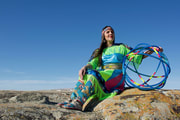|
A few months ago my sisters and I were invited to be part of the Grand Opening of the brand new City of Lethbridge, Community Arts Center (CASA) consisting of a week-long celebration. Our collaborative, multi-disciplinary hoop dance performance titled, The Sacred Hoop, was on May 14, 2013.
The main piece in the show was Sagowsko (Bush Woman), a nickname given to me from my mother because I enjoy picking medicines in the forest. Sagowsko was inspired by the hoop dance story I was taught when I first started learning to hoop dance in 2005. It is a Nishnaabeg story and can be found in Basil Johnston’s book “The Manitous: The Spiritual World of the Ojibway”. The story is about Pukawiss, the disowned one, who was fascinated with nature. He became disowned by his father who wished he was more like his older brother a great hunter and warrior. Pukawiss leaves his family and does performances for different villages and eventually creates the hoop dance. This was the fourth time this piece has been performed and has continued to grow and evolve. We added a new opening scene that expressed the sacredness and strengths of Native women. This was followed by the exploration or discovery scene in which the main character, Sagowsko, is seen exploring in nature and mimicking the animals around her. The third scene is being lost and alone and represents the disconnection we have when we do not fit into the expectations of society. In this case Sagowsko was supposed to be picking berries like her sisters, but instead she wanted to explore the world around her. As a result she finds herself alone and lost… The final scene is about re-connection and the gift of the hoop dance. From being alone and afraid Sagowsko finds herself on the ground, where she very literally feels ‘the heartbeat of the earth’ and is able to re-connect with the world around her. The ‘hoop spirits’ enter and imbue her with their spiritual energies, the energies of creation… birds, butterflies, eagles and dance. It represents a sort of healing ritual one may experience when they are able to be themselves, to live in a connected way with their identity and the world around them. Through re-connection there is also a process of re-creation. Each time this piece has been performed it has brought audience members to tears, even though people comment that it is beautiful and uplifting. Sagowsko was very much an exploration of Resurgence Theory, which is a relatively new theory in Indigenous Knowledge although based in very ancient stories and traditions. This theory is explained by Dr. Leanne Simpson in her book, “Dancing on Our Turtles Back: Stories of Nishnaabeg Re-Creation, Resurgence, and a New Emergence” where she talks about the Seven Fires Prophecy of the Nishnaabeg. There are similar stories found in other First Nations cultures, including Blackfoot and Cree, although the details are slightly different. It often begins with conflict or war followed by a great flood and finally the re-creation of the earth by the ‘trickster’ (Waynabozhoo/ Weesagechak/ Naapi) with the help of the animals. Simpson explains that this is not a creation story, but a re-creation story. She describes it as a cycle of creation – destruction – re-creation found in Nishnaabeg thought. After interpreting the hoop dance story of Pukawiss through the lens of resurgence theory I began to see the cycle identified by Dr. Leanne Simpson as one of connection – disconnection – re-connection. This reflected the teachings of the hoop dance and represented the re-connection with identity and with the self, which is reflected in the story of Pukawiss and Sagowsko as well as in my own life. For me, it was the hoop dance that allowed me to find a re-connection with myself, my identity and the world around me. In the Nishnaabeg story a piece of earth is placed on the turtle’s back and, “Waynabozhoo began to sing. The animals danced in a clockwise circular fashion and the winds blew, creating a huge and widening circle. Eventually, they created the huge island on which we live, North America” (69). Dr. Simpson’s interpretation proclaims, “Together, we have all of the pieces. In Nishnaabeg thought, resurgence is dancing on our turtle’s back; it is visioning and dancing new realities and worlds into existence” (70). This was especially meaningful for me because inclusiveness and working together is embodied in the hoop itself. Also, the image of ‘dancing new realities and worlds into existence’ was re-affirming as a dancer and emerging choreographer, because I intentionally focus on healing and Nitonahk Miyo Pimadisiwin- Seeking a Good Life in my choreography. Dance is one of the ways that we can re-connect the sacred hoop which has been broken through colonization and assimilation as we re-create our reality to benefit all of creation. Hiy-hiy. This performance sponsored by the Allied Arts Council of Lethbridge.
3 Comments
|
Nehiawsko Pikiskwew'Cree Woman Speaking' is a space to share my voice. My goal is to spread awareness and share wisdom as I learn and grow as a dancer, choreographer, and woman. My passion is to show the healing power of dance and culture. I love learning from elders, experience, and research and being able to synthesize Native and non-Native ways of knowing! Archives
November 2023
Categories
All
|

